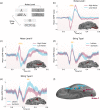From letters to composed concepts: A magnetoencephalography study of reading
- PMID: 34402114
- PMCID: PMC8449097
- DOI: 10.1002/hbm.25608
From letters to composed concepts: A magnetoencephalography study of reading
Abstract
Language comprehension requires the recognition of individual words and the combination of their meanings to yield complex concepts or interpretations. This combinatory process often requires the insertion of unstated semantic material between words, based on thematic or feature knowledge. For example, the phrase horse barn is not interpreted as a blend of a horse and a barn, but specifically a barn where horses are kept. Previous neuroscientific evidence suggests that left posterior and anterior temporal cortex underpin thematic and feature-based concept knowledge, respectively, but much remains unclear about how these areas contribute to combinatory language processing. Using magnetoencephalography, we contrasted source-localized responses to modifier-noun phrases involving thematic relations versus feature modifications, while also examining how lower-level orthographic processing fed composition. Participants completed three procedures examining responses to letter-strings, adjective-noun phrases, and noun-noun combinations that varied the semantic relations between words. We found that sections of the left anterior temporal lobe, posterior temporal lobe, and cortex surrounding the angular gyrus were all engaged in the minimal composition of adjective-noun phrases, a more distributed network than in most prior studies of minimal composition. Of these regions, only the left posterior temporal lobe was additionally sensitive to implicit thematic relations between composing words, suggesting that it houses a specialized relational processing component in a wider composition network. We additionally identified a left occipitotemporal progression from orthographic to lexical processing, feeding ventral anterior areas engaged in the combination of word meanings. Finally, by examining source signal leakage, we characterized the degree to which these responses could be distinguished from one another using source estimation.
Keywords: angular gyrus; anterior temporal lobe; composition; magnetoencephalography; posterior temporal lobe; semantics.
© 2021 The Authors. Human Brain Mapping published by Wiley Periodicals LLC.
Conflict of interest statement
The authors declare no conflict of interest in the completion of this work.
Figures







Similar articles
-
Compositionality and the angular gyrus: A multi-voxel similarity analysis of the semantic composition of nouns and verbs.Neuropsychologia. 2015 Nov;78:130-41. doi: 10.1016/j.neuropsychologia.2015.10.007. Epub 2015 Oct 18. Neuropsychologia. 2015. PMID: 26454087 Free PMC article.
-
How the conceptual specificity of individual words affects incremental sentence composition: MEG evidence.Brain Lang. 2021 Jul;218:104951. doi: 10.1016/j.bandl.2021.104951. Epub 2021 Apr 21. Brain Lang. 2021. PMID: 33894598
-
Building words and phrases in the left temporal lobe.Cortex. 2018 Sep;106:213-236. doi: 10.1016/j.cortex.2018.06.004. Epub 2018 Jun 21. Cortex. 2018. PMID: 30007863
-
The neural basis of combinatory syntax and semantics.Science. 2019 Oct 4;366(6461):62-66. doi: 10.1126/science.aax0050. Science. 2019. PMID: 31604303 Review.
-
The neural underpinnings of word comprehension and production: The critical roles of the temporal lobes.Handb Clin Neurol. 2022;187:211-220. doi: 10.1016/B978-0-12-823493-8.00013-4. Handb Clin Neurol. 2022. PMID: 35964973 Review.
Cited by
-
Left posterior temporal cortex is sensitive to syntax within conceptually matched Arabic expressions.Sci Rep. 2021 Mar 30;11(1):7181. doi: 10.1038/s41598-021-86474-x. Sci Rep. 2021. PMID: 33785801 Free PMC article.
-
The role of left angular gyrus in the representation of linguistic composition relations.Hum Brain Mapp. 2022 May;43(7):2204-2217. doi: 10.1002/hbm.25781. Epub 2022 Jan 22. Hum Brain Mapp. 2022. PMID: 35064707 Free PMC article.
References
-
- Adachi, Y., Shimogawara, M., Higuchi, M., Haruta, Y., & Ochiai, M. (2001). Reduction of non‐periodic environmental magnetic noise in MEG measurement by continuously adjusted least squares method. IEEE Transactions on Applied Superconductivity, 11(1), 669–672. 10.1109/77.919433 - DOI
Publication types
MeSH terms
LinkOut - more resources
Full Text Sources

